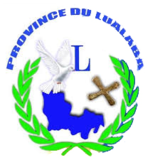- The emblem of Lualaba Province.
- The emblem of Haut-Katanga Province.
- The flag of the historical breakaway State of Katanga.
You can help expand this article with text translated from the corresponding article in Spanish. Click [show] for important translation instructions.
|

A Katanga cross (French : croisette du Katanga), also called a handa, is a cast copper ingot in the shape of an equal-armed cross which was once used as a form of currency in parts of what is now the Democratic Republic of the Congo (DRC) in the 19th and early 20th centuries. Katanga crosses were made in various sizes, typically about 20 centimetres (7.9 in) across, and weighing about 1 kilogram (2.2 lb). The name derives from Katanga, a rich copper mining region in the south-eastern portion of the DRC. [1]
Contents
These X-shaped ingots were cast by local coppersmiths by pouring molten copper into sand molds. [1]


